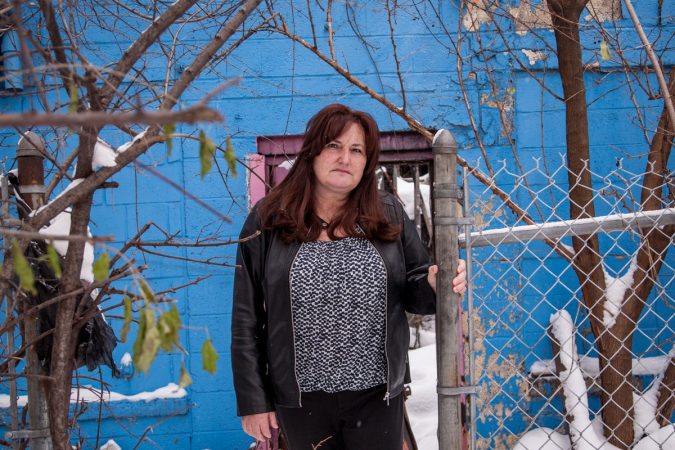Deborah Monroe was 10 when her mother, never much for mothering, went to Bingo. She never came home. Her father, who was typically juiced to begin with, couldn’t handle single parenthood. She and her brothers were put in foster care and shifted from house to house. One day, when things couldn’t get worse, one of Deborah’s foster parents confirmed her darkest fear: they did not love Deborah.
So, at 13, Deborah did the only thing she had left in her to do: she ran away to the circus. She’d heard about people doing that. In reality it was just a fair, Michigan’s Jackson County Fair, but in Deborah’s mind, that was close enough. Since she’d always felt rejected, she figured she’d be able to relate to the “bearded lady” and other carnie types. Her plan was to make them her family. Anything, including fantasy, was better than the life she was living. Her first night there, she slept under one of the rides.
“The second day, I ran into someone who paid attention to me, and bought me a hot dog or whatever,” Deborah said. “I felt comfortable with him. The next thing I knew I was at a motel at 13 Mile and Woodward Ave. He bought me some Wendy’s and left me there for the night.”
The next morning, the 19-year old drove Deborah back to the fairgrounds, slipped her 20 bucks, and told her that if she wanted to be with him, she’d still be there in an hour. If she didn’t, she should use the cash and return to foster care.
“I thought, what’s wrong with me that nobody wants me. I was terrified he wasn’t coming back. When he did, we went to some place in Detroit. That night he had sex with me. I was a virgin. The second night, he put me to work.”
For the next 43 years Deborah was trafficked for sex.
In many ways not unique to Detroit, the city is a trafficking hotbed. It’s easier to get lost in a big city, and when you add homelessness, poverty, and a substandard school system, the breeding grounds are ripe.
But Detroit has something else that could factor in: a growing economy, particularly downtown.
Experts say it’s difficult, if not impossible, to know the true scope of sex trafficking, generally defined as using force, fraud, or coercion to control another person for the purpose of engaging in commercial sex.
They’re loathe to quantify it, arguing that some data are mere snapshots of alleged sex crimes committed on a single day. Others cite misperceptions about the crime as well as honest differences about what constitutes trafficking. Moreover, simply too many such crimes are never reported.
“The numbers are gray or anecdotal, so collecting data is difficult and cumbersome,” said Aleksandra Andjelkovic, director of the Salvation Army’s Detroit-based Anti-Human Trafficking Initiative, part of the federally funded Joint Anti-Trafficking Task Force (JATT).
Still, it is seldom disputed that, globally, approximately 20 million people are currently entrapped in some form of slavery, including sex trafficking, labor trafficking, and domestic servitude. In terms of crime prevalence, most estimates put human trafficking at second, behind drug trafficking. Counterfeiting runs a close third.
Sex trafficking is big business
The International Labour Organization, an arm of the United Nations, estimated that international profits linked to human trafficking totaled roughly $150 billion in 2012, the most recent data available. Of that, about $100 billion was tied to sexual exploitation.
By at least one widely reputable measure, the National Human Trafficking Hotline, shows such activity is growing in the United States. By the first half of 2017, some 3,186 cases were reported nationally. That compares with 5,593 for all of 2016, and 4,183 for 2015.
Michigan mirrors that increase. By June of 2017, 109 sex trafficking cases were reported. There were 195 cases for all of 2016, and 123 cases for 2015. With 705 trafficking reports, California tops the list that includes all 50 states.
Most of the reported Hotline cases nationally and statewide involve white women; minors make up about one-third.
In the last two years, JATT has worked with as many as 140 cases of human trafficking, many of them involving sex trafficking, Aleksandra tells us. In addition, there’s been a hike in the number of referrals to service providers, and an increase in the number of suspected-trafficking raids. JATT conducted two raids in 2016, but nine from January through November of last year. “Detroit, these days, sees a lot of sex trafficking, not much reported labor trafficking, because we do not receive as many tips or referrals,” she said.
Awareness is increasing, as we are seeing more and more people who are understanding what trafficking is.
Locally, there have been high-profile gets. Early last year, in one of the biggest raids in Detroit history, sex traffickers were found to have been working out of all but a couple of rooms at Detroit’s Victory Inn Motel. And as part of an annual human trafficking national sting last October that netted 84 children and 120 traffickers, 12 minors were recovered in Michigan alone, and eight sex traffickers or pimps were arrested.
Michigan has also been proactive legislatively. Based on a 2013 report by the Michigan Commission on Human Trafficking, Gov. Rick Snyder (R) signed a package of bills a year later that aimed to crack down on human trafficking and help victims. Provisions included harsher penalties for perpetrators and people who pay money for sex, and state protection for juveniles rescued from the sex trade. In 2016, new laws provided more assistance to human trafficking survivors and further stiffened penalties for those who coerce victims to engage in commercial sex. Last May, Snyder signed legislation that allows more victims of human trafficking to have their criminal records expunged. Up to that point, victims were ineligible if they had previous prostitution-related cases on their record.
However, Bridgette Carr, founder of a human trafficking legal clinic at the University of Michigan, has taken issue with how some laws were written. For example, some of the language bases victimhood on compliance with court orders rather than the experience of those trafficked, she said.
In reality, laws are just the starting point
“We are trying to move a massive paradigm. You can pass a law that gives people protection, but you can’t pass a law that gets in someone’s brain that tells them to stop,” Carr said. “We haven’t made the shift yet from saying all these people are criminals to perhaps they’ve been exploited.”
Much of victims’ vulnerability, she said, is linked to unemployment and a lack of education and family support. This is compounded by consumers and those who choose to traffic, plus a public that generally looks the other way.
“All people want to know is whether their daughter will be safe when she goes on spring break,” Carr said.
High school dropouts are particularly vulnerable, said Celia Thomas, chief operating officer of the Detroit-based non-profit, Alternatives for Girls, which services high-risk girls and young women. Detroit’s high school graduation rate inched up in 2016 over the year before, from 77.35 percent to 78.30 percent, but is still the lowest among the 10 Michigan districts with the largest number of high school students. Those with less than a high school diploma are at a whopping 346 percent higher risk of becoming homeless, Thomas said.
“And this doesn’t always mean sleeping at Belle Isle or Hart Plaza,” Thomas said. “It could mean staying with someone in exchange for sex or using their food stamps in order to stay there. The extent to which Detroit decides to address issues around youth and education and improving the odds for youth as it relates to homelessness and trafficking will say a lot about the future.”
The danger of being trafficked lurks early. The average age of sex trafficking victims is between just 12 and 14, said Melissa Novock, a human trafficking specialist at WC Safe, which provides services to human trafficking survivors in Detroit.
“We can’t continue to criminalize someone if we’re really survivor centered,” she said, adding that up to 90 percent of children who are sexually exploited have a history of sexual abuse. “We have to look at what age these girls were coerced into this life.”
A police officer told me that back in the day we’d just lock the women up. We didn’t take the time to see whether they’d been forced to do this, Melissa said, noting the difference between trafficking and prostitution.
Experts such as Jane White say prevention is key. A former police officer, Jane has directed the Michigan Human Trafficking Task Force for the last 12 years. She said communities need to get more involved, and there needs to be more law enforcement buy-in. There also needs to be stiffer penalties for “johns” — a nickname for those that solicit illicit sex — particularly when minors are involved.
In addition, more health care professionals must learn to spot signs of trafficking, and local governments need to get serious. “When the federal government makes funding available to combat human trafficking, local governments must follow through,” she said.
Getting Help
There is more help for survivors available, including the new Sanctum House in Royal Oak, Mich. The shelter offers a bed and two years of rehabilitation, health care, and other support, and is thought to be the first human trafficking shelter of its kind in southeastern Michigan. Deborah Monroe plans to assist the program, established by former trafficking victim, Edee Franklin, as a peer-to-peer counselor.
In Detroit, what’s ironic is that the city’s long-coming progress could lead to more trafficking. “It means more opportunity to sell girls,” Melissa said. “All the activities like music fests, sporting events, and all the casinos, this causes trafficking activity to spike. A lot of work is done not on the street but in hotels. So, Detroit is expanding in one way, but now there are these other issues.”
Growing class disparities created by the emphasis on downtown and Midtown areas also contribute to prospective trafficking. “If you go outside that three or four-mile radius, you can see that the divide is growing,” she said. “And that’s where vulnerability comes in.” All it takes for some girls is the promise of the ability to buy new athletic shoes.
Yet, the face of the trafficked defies stereotype. Theresa Flores hailed from a well-to-do, predominately white Michigan suburb. At 15 she was targeted by a group of men, one of whom she’d developed a crush on. That man drugged and raped her, then blackmailed her with photos of the incident. For two years she was made to service men, all while she lived at home, attempting to keep her family safe.
On her worst night, Theresa was sold to nearly two dozen men who exploited her sexually in a Detroit flophouse. During the horror, Theresa kept thinking that, once it was all over, she could take soap and wash it off. Now 51 and a prominent campaigner against sex trafficking, she’s also the founder of S.O.A.P. (Save Our Adolescents from Prostitution), which has nine chapters in Michigan alone. She gathers volunteers to put labels with the Nation Human Trafficking Hotline on soap bars and distributes them free to motels.
Like many trafficking victims, Theresa hadn’t considered herself a prostitute, but she didn’t know what to call her experience. After suicide attempts and an abusive marriage, she learned the term by happenstance in 2006 while attending a conference.
“When I found out the definition, it was like, oh my gosh,” she said. “I was glad but devastated at the same time. Here I was 40 years old with a master’s degree, and I didn’t know this.”
The mother of two daughters, Theresa calls human trafficking a silent epidemic.
“As hard as all of us activists are working, it’s so shocking that people don’t have a clue,” said the author of The Slave Across the Street (Random House, 2013). “I tell everyone it happens to people who look like them, too. I really do think it’s happening in every zip code.”
Although every situation is different, Aleksandra said it typically takes someone that’s being trafficked several contacts with service providers before they leave the life.
“Their perception of the world is cruel and brutal,” Aleksandra said. “If she’s addicted to drugs that the trafficker injects, she won’t wander too far away from him. And if they walk out and have no money, they’re going to call the trafficker first. Those who succeed are finally ready.”
For most, the road is long and hellish
Although Deborah would give her john every dime she made, he’d still beat her down, both physically and mentally. For extra money, she was forced to strip at clubs, where she’d meet guys and on breaks have sex with them at nearby motels. Yet, when the FBI arrested her pimp for a variety of offenses, she refused to testify. She tried to escape a few times but always returned.
“I loved him. As much as I knew how,” she said.
Early on, her trafficker wouldn’t allow her to do drugs, not out of care for her, but because a habit of hers would eat into his take. Ultimately, she needed something to ease the pain, turning to crack in her early 20s.
She would have three babies, two fathered by “tricks,” the other by a man she knew. One child the state took. The two others were placed in foster care. All the while, she continued to sell herself and use drugs.
She got arrested for possession.
“It was just a small quantity, but I asked to be put in prison. I knew I was going to die out there, and I wanted to die. I was just too afraid to do it myself,” said Deborah, who ended up serving a short sentence.
Getting arrested saved my life because I started to feel like I was doing to my kids what my mother did to me. So, I decided I was going to make changes.
But it wasn’t that easy. After relapsing a few times, Deborah, who’d been on the street from the age 13 to 38, got her first job, a minimum wage position and tried to get her own apartment.
“I didn’t know how to pay bills or do anything I should’ve learned 20 years earlier, so I struggled,” she said. “I hadn’t been to school since the 8th grade.”
Soon, she was jailed for violating parole by living with a convicted felon. Shortly after she got out, her trafficker was imprisoned. After a few more relapses, she left the life for good in 2009. She got a subsidized apartment and two of her children back. They all went into counseling, and she started in parenting classes.
“I had a hard time with my kids, even them hugging me, because anytime I’d touched someone there was a transaction, there was money involved,” said Deborah, who became a certified peer support specialist. “Now I can do it without discomfort.”
Still, Theresa Flores, now a happily married mother, said survivors should expect lasting effects. “I don’t think anybody gets out scot-free from this,” she said. “The mental health repercussions are horrific, and I’ve had my fair share of struggles since getting out.”



















